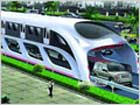| Videos | • Latest |
|
• Feature | • Sports | • Your Videos |
Straddling bus aims to cut traffic jam

Traffic in Beijing and other big cities in China is a growing problem as more people move in from the countryside and buy cars.
An inventor has come up with an idea for a new kind of bus that would ease the congestion by straddling lanes, carrying passengers in the unused space above cars.
Six lanes of gridlock on one of Beijing's ring roads - it's another typical day in China's crowded capital.
But a new idea in urban transportation is aimed at changing that.
Inventor Song Youzhou's brainchild is the straddling bus. The odd-looking machine would share the road with other traffic, elevating passengers on narrow legs, allowing cars to drive underneath.
Song is hopeful his creation can help ease urban traffic woes and reduce costs for public infrastructure.
At his company's offices on the outskirts of Beijing, Song has a working miniature model of the bus, which looks more at home in an old science fiction magazine than on city streets.
Song's company has not produced a prototype yet, but the idea is gaining attention from domestic and international media along with potential buyers. "Many people originally doubted the safety of trams and trolleys driving on the same road with other vehicles, Take the Central Link in Hong Kong - which I have observed and studied - as an example. As photos taken there show, there are several pairs of tracks with double-decker trams driving on them. Other cars and buses are driving along with those trams. They have been driving along for decades, but it's never been said that an unusual number of traffic accidents happen there."
Chinese mega cities like Beijing need all the help they can get.
Traffic has become a huge urban problem as more and more individuals purchase private cars.
Bikes, which were once ubiquitous in China, have largely disappeared and the streets are now congested with traffic all day long. And every day more people are moving into the cities from rural areas.
Unlike conventional buses, which stop when the traffic does, Mr. Song's bus would continue to move. It would be powered by electricity.
"If we take a bus, a common bus consuming gasoline, and it meets with a traffic jam, the bus will be held in the jam with other vehicles. But straddling buses will not be held in the jam with other vehicles. Instead, straddling buses will drive right over the traffic jam."
The straddling buses would have to be extra wide - as wide as two lanes - for stability and to allow room for traffic to manoeuvre underneath.
Advanced electric motors mounted on the legs would provide propulsion.
Spaces between the legs would let in light and keep motorists from getting disoriented.
Bus stops could be built on overpasses to keep passengers off the roads as well.
The bus may provide alternatives for smaller cities to expand as well.
Zhang Wenbo, visiting scholar at the Ecology Centre of the Chinese Academy of Sciences, has been investigating on the feasibility of the bus - and particularly its environmental impact.
"The invention of a straddling bus is innovative, because straddling buses can help to increase the transportation capacity of a given road without adding to the traffic density on the ground." he says.
Zhang also likes the fact that the electric bus would help the city meet "green goals" set out by the central government - and could make funding more easy to come by as the government puts stimulus money into alternative energies and low carbon development.
"Theoretically, straddling buses are similar to subways in terms of the way they add transportation without adding traffic congestion on the ground. So straddling buses cost less than almost all the transportation facilities we are now using."
Song is hopeful production will begin in a few months at the China South Locomotive and Rolling Stock Corporation's facility's in the nearby city of Shijiazhuang.
 0
0 







Go to Forum >>0 Comments